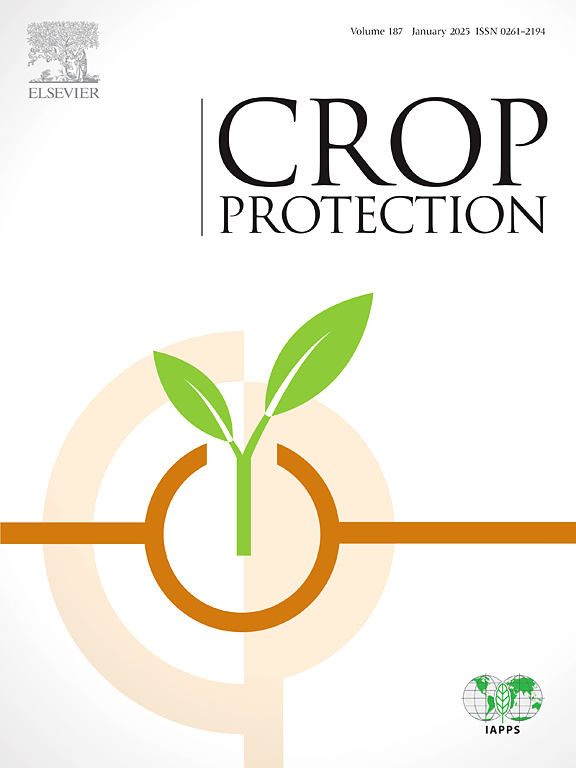通过狭窄的空间布局提高菊科杂草的竞争力
IF 2.5
2区 农林科学
Q1 AGRONOMY
引用次数: 0
摘要
奇异籽(Salvia hispanica L.)是一种前景广阔的作物,被视为欧米伽-3 的可持续来源。然而,由于杂草竞争和缺乏注册除草剂,奇异籽的产量和质量都有所下降。本研究评估了奇异籽的空间布局如何抑制杂草生长,并为这种作物提供了管理方案。在三个生长季的田间试验中,采用因子设计评估了奇亚籽植物的表现,该设计考虑了空间布局(窄和宽)、杂草管理(无杂草对照、土库黄花菜(Brassica rapa L.)和播种黄花菜)和覆盖作物(在奇亚籽休耕期间有无黑麦(Secale cereale L.)覆盖作物)。奇亚籽和黄刺玫不能互补,导致资源竞争(相对总产量约为 1)和相互间的负面影响。杂草在总生物量中所占比例每增加一个单位,奇亚籽的谷物产量就会大幅下降 0.9%。由于奇异菊比黄花菜更有竞争优势,谷物减产的情况在狭窄的空间布局下得到了改善。窄空间布局可在早期生长阶段加快冠层闭合,减少光照穿透,抑制杂草生长。奇异果的高消光系数(0.91)和低临界 LAI(3.3)促成了这种截光行为。因此,为了最大限度地提高芝麻的产量和收益,狭窄的空间布局是抑制杂草的有效管理策略。这项研究为了解奇异草与杂草的相互作用提供了宝贵的见解,并强调了可持续作物管理方法的重要性。本文章由计算机程序翻译,如有差异,请以英文原文为准。
Competitiveness of chia against brassica weeds improves through a narrow spatial arrangement
Chia (Salvia hispanica L.) is a promising crop valued as a sustainable source of omega-3. However, chia yield and quality are reduced because of weed competition and the lack of registered herbicides. This study evaluated how chia spatial arrangement suppresses weed growth and provided management options for this crop. The performance of chia plants was assessed over three growing seasons in field experiments using a factorial design that considered spatial arrangement (narrow and wide), weed management (control without weeds, soil bank brassica (Brassica rapa L.), and sown brassica), and cover crop (with or without a rye (Secale cereale L.) cover crop during chia fallow). Chia and brassica are not complementary, leading to resource competition (relative yield total around 1) and negative effects on each other. A significant decrease in chia grain yield of 0.9% per unit increase in the percentage of weeds in total biomass was observed. As chia had a competitive advantage over brassica, the grain yield reduction was ameliorated with a narrow spatial arrangement. Narrow spatial arrangement promotes faster canopy closure during the early growth stages, decreasing light penetration and suppressing weed growth. The high extinction coefficient of chia (0.91) and the low critical LAI (3.3) contributed to this light interception behavior. Accordingly, to maximize chia productivity and profitability, a narrow spatial arrangement is an effective management strategy to suppress weeds. This study contributes valuable insights into chia-weed interactions and emphasizes the importance of sustainable crop management practices.
求助全文
通过发布文献求助,成功后即可免费获取论文全文。
去求助
来源期刊

Crop Protection
农林科学-农艺学
CiteScore
6.10
自引率
3.60%
发文量
200
审稿时长
29 days
期刊介绍:
The Editors of Crop Protection especially welcome papers describing an interdisciplinary approach showing how different control strategies can be integrated into practical pest management programs, covering high and low input agricultural systems worldwide. Crop Protection particularly emphasizes the practical aspects of control in the field and for protected crops, and includes work which may lead in the near future to more effective control. The journal does not duplicate the many existing excellent biological science journals, which deal mainly with the more fundamental aspects of plant pathology, applied zoology and weed science. Crop Protection covers all practical aspects of pest, disease and weed control, including the following topics:
-Abiotic damage-
Agronomic control methods-
Assessment of pest and disease damage-
Molecular methods for the detection and assessment of pests and diseases-
Biological control-
Biorational pesticides-
Control of animal pests of world crops-
Control of diseases of crop plants caused by microorganisms-
Control of weeds and integrated management-
Economic considerations-
Effects of plant growth regulators-
Environmental benefits of reduced pesticide use-
Environmental effects of pesticides-
Epidemiology of pests and diseases in relation to control-
GM Crops, and genetic engineering applications-
Importance and control of postharvest crop losses-
Integrated control-
Interrelationships and compatibility among different control strategies-
Invasive species as they relate to implications for crop protection-
Pesticide application methods-
Pest management-
Phytobiomes for pest and disease control-
Resistance management-
Sampling and monitoring schemes for diseases, nematodes, pests and weeds.
 求助内容:
求助内容: 应助结果提醒方式:
应助结果提醒方式:


